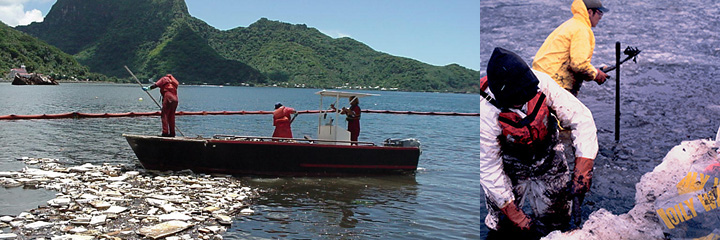What Does It Take to Clean up the Cleanup From an Oil Spill?
FEBRUARY 9, 2015 -- Imagine spilling a can of paint on your basement floor. Luckily, you have some paper towels nearby, and maybe some rags or an old towel you can use to mop up the mess.
When you're finished, all of those items probably will end up in the garbage. Maybe along with some of the old clothes you had on.
You might not think much about the amount of waste you generated, but it was probably a lot more than the volume of paint you spilled—maybe even 10 times as much. That number is actually a rule of thumb for oil spill cleanup.
The amount of waste generated is typically about 10 times the volume of oil spilled.
Our colleagues at the International Tanker Owners Pollution Federation (ITOPF) did a study on this very topic, looking at the oil-to-waste ratio for nearly 20 spills [PDF]. (A messy job, for sure.) ITOPF found that the general rule for estimating waste at oil spills still held true at about 10 times the amount spilled.
The Mess of a Cleanup
What kinds of wastes are we talking about?
Well, there is the oil recovered itself. In many cases, this can be recycled. Then there are oily liquids. These are the result of skimming oil off of the water surface, which tends to recover a lot of water too, and this has to be processed before it can be properly disposed.
Shoreline cleanup is even messier, due to the large amounts of oily sands and gravel, along with seaweed, driftwood, and other debris that can end up getting oiled and need to be removed from beaches.
Some response equipment such as hard containment booms can be cleaned and reused, but that cleaning generates oily wastes too. Then there are the many sorbent materials used to mop up oil; these sorbent pads and soft booms may not be reusable and would be sent to a landfill. Finally, don't forget about the oil-contaminated protective clothing, plastic bags, and all of the domestic garbage generated by an army of cleanup workers at the site of a spill response.
Aiming for Less Mess
A large U.S. oil spill response will have an entire section of personnel devoted to waste management. Their job is to provide the necessary storage and waste processing facilities, figure out what can be recycled, what will need to be taken to a proper landfill or incineration facility, and how to get it all there. That includes ensuring everything is in compliance with the necessary shipping, tracking, and disposal paperwork.

The amount of waste generated is a serious matter, particularly because oil spills often can occur in remote areas. In far-off locales, proper handling and transport of wastes is often as big a challenge as cleaning up the oil. Dealing with oily wastes is even more difficult in the Arctic and remote Pacific Islands such as Samoa because of the lack of adequate landfill space. One of the common goals of a spill response is to minimize wastes and segregate materials as much as possible to reduce disposal costs.
In a 2008 article, the U.S. Coast Guard explores in more detail the various sources of waste during an oil spill response and includes suggestions for incentivizing waste reduction during a response.
 An official website of the United States government.
An official website of the United States government. 

